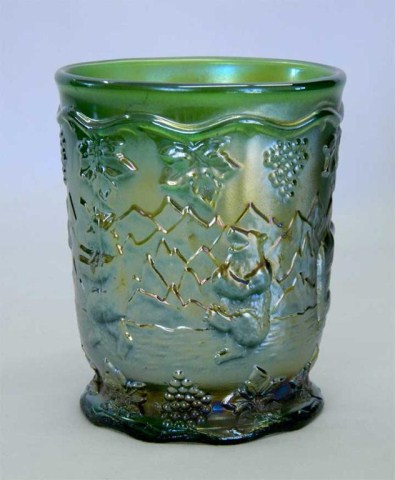By Lee Markley
In the Spring 1982 issue of The Glass Collector, William Heacock attributes the Frolicking Bears pattern to the U. S. Glass Company based on a 1910 catalog from that company housed at the Corning Museum of Glass. Their factory, located at Gas City, Indiana, was the producer. Most of the Frolicking Bears items have been found in Central Indiana.
The first reported tumbler was owned by Leslie Wolfe and is the one Hartung used to draw the pattern for her Book 3. Only about a half dozen have been located so far. The last two were purchased by Bob Gallo from a dealer whose shop was located near Decatur, Indiana. John Woody had purchased a couple from a source near Indianapolis.
One of the pitchers was found by Rex Lyons in the summer of 1973. According to the story Phyllis Lyons and Rovene Heaton had gone to the ICGA convention in Des Moines. When they got back to the Lyons’, Rex told Rovene what he’d found. However, she was anxious to get home and didn’t go in the house to look at it. Consequently she missed the opportunity to buy it. Based on Phyllis’s recollection, the pitcher was sold to a collector in Pennsylvania (probably Ray Wishard). It subsequently survived the Wishard fire. There are only three or four reported to date.
This pitcher is green, as are all known pitchers.
The first pitcher to sell publicly was in 1976 at the Collier auction. It brought $6,000; the accompanying tumbler brought $3,500. At the Cavett-Jankauer sale in February, 1978, a pitcher brought $2,400. In June of 1979 a pitcher sold at the Mogg auction for $9,200. The last sale publicly of a pitcher was in April of 1981 when one with a small chigger sold for $1,000.
A tumbler sold at the Kenneth and Lenora Elam sale in November of 1982 for $2,500. The only sales of tumblers reported in the Mordini Auction Reports were in March and October of 1999. The first one brought $12,500, and the second sold for $15,000. Any other sales have been between private individuals.
The pitcher has a four inch diameter pedestal base. It is 8 1/2 inches tall with a diameter of 4 1/2 inches at the top. There are three mold lines, and the handle is molded. The design is composed of five bears each doing a different acrobatic feat. The top rim is smooth and the handle is a vine branch. Behind the bears are mountain peaks. From a vine encircling the top hang a grape cluster with two leaves between each cluster. The scalloped, skirted base has a design of alternate grapes and leaves which point up. A vine runs around the very bottom of the skirt. No pattern is on the base, but part of the design extends part way up the outside.
Unlike the pitcher the tumbler has six bears each doing a different stunt. There are mountains in the background and what Hartung calls a “loose basketweave effect at their base.” It’s possible it represents a rustic fence. The tumblers are four inches tall and 2 3/4 inches in diameter. The same grape and leaves hanging from a vine encircle the top. They are reversed at the bottom. There are three grape clusters with two leaves between. The pattern continues up underneath the scalloped base.
The pitcher in the picture belonged to Carl and Ferne Schroeder at the time the picture was taken.
Sources:
Britt. HOACGA Educational Series II – Tumblers.
Doty. A Field Guide to Carnival Glass. 2nd ed.
Hartung. Carnival Glass Book 3.
Heacock. The Glass Collector. Spring 1982 pp 3-5.
Mordini. Auction Price Reports 1986 – 2002.
Owens. Carnival Glass Tumblers.
Thistlewood. Carnival Glass: The Magic and the Mystery.
Thistlewood. Network No. 22 / 1999.

